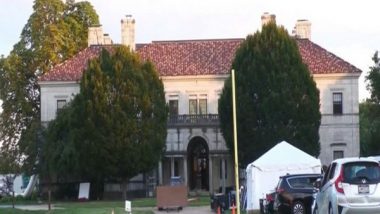It’s an exciting time for Nadiah Rivera Fellah . Associate curator of contemporary art at the Cleveland Museum of Art, Fellah has seen the openings at CMA in recent weeks of two passion projects: “Rose B. Simpson: Strata” and “Picturing the Border.
” Let’s start with the former, as a museum visitor would have to work to miss it. Residing in CMA’s wide-open, naturally lit Ames Family Atrium, “Strata” consists of two huge sculptures by New Mexican Artist Simpson made with her signature clay, along with metalwork, porous concrete and cast bronze, according to CMA press materials. The museum commissioned the exhibition, marking only the second time — following 2019’s “Ámà: The Gathering Place” — it had done so for the space that opened in 2012, Fellah says in a recent phone interview.

“A few years later, we wanted to do it again because — you know if you’ve been to the CMA — the Atrium is such a great large space,” she says. “And we’ve found that visitors really love when it’s activated with artwork. It’s free to enter, and people meet there; you can read, relax, get a meal — so it’s a great place to encounter art.
” The art visitors will encounter there through mid-April stands tall, with each figural sculpture reaching 25 feet into the air. The pieces are, at least in terms of size, a contrast to the work of Simpson that impressed Fellah and other CMA personnel in the multi-artist exhibition “Picturing Motherhood Now,” which ran for about five months starting in fall 2021. “When we had those works on display, which were quite small, we noticed that they were extremely well-crafted,” Fellah says.
“You could tell that she gave such care to elements of her sculptures; you could sort of see her fingerprints in the clay, so they were beautiful up close. “But also they strike these really beautiful forms from a distance, so we thought what a perfect artist (for) the Atrium, where you can get the sightlines from far away.” The award-winning Simpson then spent time in Cleveland, the idea being that the space the pieces would reside would help to inspire them, as would the Native American woman’s cultural heritage and “the landscape of her ancestral homelands of Santa Clara Pueblo, New Mexico, where she was born and raised and where she lives and works,” state press materials.
“Simpson’s identity as a Native woman has greatly impacted her work,” they continue. “She is from a long line of women working in the ceramic tradition of her Kha’po Owingeh (Santa Clara Pueblo) tribe dating back to the 500s CE. Her large-scale sculptures represent a bold intervention in colonial legacies of dependency, erasure, and assimilation, and balance her tribe’s inherited ceramic tradition with modern methods, materials, and processes.
Her work asserts a pride of place and belonging on land where Native residents have been forcefully dispossessed of their territories and cultures.” Cleveland Museum of Art hosting ‘Korean Couture: Generations of Revolution’ /*! This file is auto-generated */!function(d,l){"use strict";l.querySelector&&d.
addEventListener&&"undefined"!=typeof URL&&(d.wp=d.wp||{},d.
wp.receiveEmbedMessage||(d.wp.
receiveEmbedMessage=function(e){var t=e.data;if((t||t.secret||t.
message||t.value)&&!/[^a-zA-Z0-9]/.test(t.
secret)){for(var s,r,n,a=l.querySelectorAll('iframe[data-secret="'+t.secret+'"]'),o=l.
querySelectorAll('blockquote[data-secret="'+t.secret+'"]'),c=new RegExp("^https?:$","i"),i=0;i
style.display="none";for(i=0;i
source===s.contentWindow&&(s.removeAttribute("style"),"height"===t.
message?(1e3<(r=parseInt(t.value,10))?r=1e3:~~r<200&&(r=200),s.height=r):"link"===t.
message&&(r=new URL(s.getAttribute("src")),n=new URL(t.value),c.
test(n.protocol))&&n.host===r.
host&&l.activeElement===s&&(d.top.
location.href=t.value))}},d.
addEventListener("message",d.wp.receiveEmbedMessage,!1),l.
addEventListener("DOMContentLoaded",function(){for(var e,t,s=l.querySelectorAll("iframe.wp-embedded-content"),r=0;r
length;r++)(t=(e=s[r]).getAttribute("data-secret"))||(t=Math.random().
toString(36).substring(2,12),e.src+="#?secret="+t,e.
setAttribute("data-secret",t)),e.contentWindow.postMessage({message:"ready",secret:t},"*")},!1)))}(window,document); Early on, Fellah says, the concept was to have the figures face each other — to be “witnessing” one another from two sides of the Atrium, setting a tone for a museum visit.
“I would encourage people to walk between them,” she says. “What I find most striking about them is the combination of materials and elements.” Simpson spent months creating them with some help from assistants at her New Mexico studio and a metal fabricator, Fellah says, before they were transported to Cleveland.
Each of the four main components — the two sculptures and a base for each — weighs in at about a ton. “Seeing them come together in the atrium, I appreciated how extremely carefully crafted (they are) and the attention to detail that went into every single element of the sculptures,” says Fellah, who is among the contributors to the exhibition’s illustrated catalog. As its curator, Fellah had a more active hand in the creation of “Picturing the Border,” which, she says, stems from a dissertation as part of her work toward her doctorate.
It consists of the work of several photographers — some with Latinx, Chicano/a and Mexican backgrounds — as well as a large photo mural, two video works and picture books. “It started as this moment of looking at this really hot-button topic, the U.S.
-Mexico border, and everything that it’s come to stand for politically, economically, militarily,” she says. The images taken from the 1970s through recent years paint a complex portrait of life near the border, the press materials stating they include intimate domestic portraits, narratives, political demonstration and clashes between migrants and the U.S.
Border Patrol. “The earliest images in this exhibition form an origin story for the topicality of the US-Mexico border at present and demonstrate that the issues of the border have been a critical point of inquiry for artists since the 1970s,” state the press materials. “Many serve as counternarratives to the derogatory narratives of migration and Latino/as in the US that tend to circulate in the mass media.
” “A lot of the photographers in the show are border residents themselves or have spent significant time on the border,” Fellah says. “And they’re starting to sort of take back the narrative and showing the borderlands in different ways — not the dominant way that (they’ve) been seen in the media — that (do not) support the tropes and cliches that people carry about that space. “What I hope is that people start to develop a broader understanding of what life in the borderlands is like,” she continues, adding that these areas are neither distinctly of the United States nor of Mexico.
“It’s this hybrid, unique amalgamation of both in terms of language, culture, influence, identity — and the people that live there, who call it home, have a unique sense of this hybrid culture within their homes, within their communities.” While Fellah was born in Ohio and raised in the Bowling Green area, her mother is from a part of Texas along the border. You need not be from a border state yourself to connect with the show, its curator says.
“I hope that a lot of people will identify with it in their own way.” She singled out the work of Ada Trillo, a contemporary photographer who, Fellah says, in recent years has chronicled migrant caravans. Trillo also created a book that’s in the exhibition, “La Caravana del Diablo,” from her time riding with migrants on the dangerous La Bestia, aka “The Beast,” a train traveling a route from southern Mexico to the borderlands.
Among Trillo’s other contributions is a large black-and-white photograph from 2020, “Sleeping by the River, Tecun-Uman Guatemala,” that she has gifted to the museum. “We’re lucky to have that photograph now in our permanent collection,” Fellah says, “and it’s on view as part of this exhibition.” Again, this is an exciting time for her, thanks to CMA visitors being able to experience both “Picturing the Border” and “Rose B.
Simpson: Strata.” “It’s very surreal, but it’s incredibly satisfying,” she says. “It is the culmination of a lot of work, but it also is a team effort — we have a great team at the CMA.
” Where: Cleveland Museum of Art, 11150 East Blvd. When: “Picturing the Border,” through Jan. 5; “Rose B.
Simpson: Strata,” through April 13. Admission: Free. Info: ClevelandArt.
org or 216-421-7350..



















